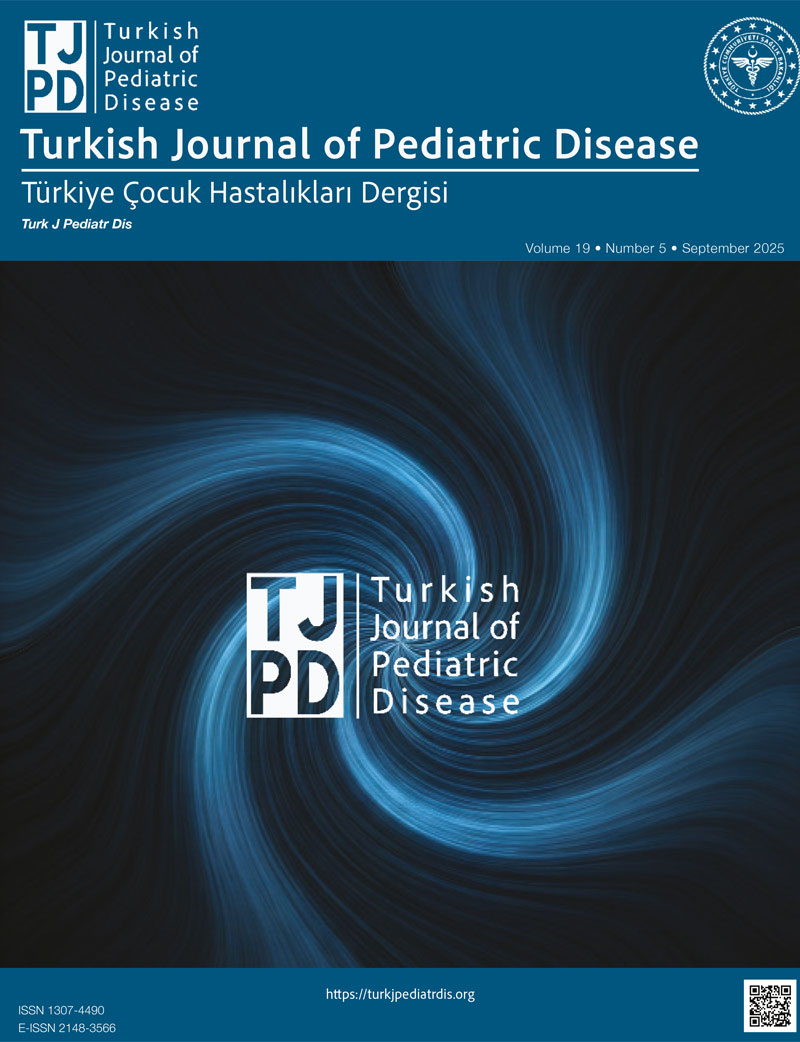Abstract
Objective: Kawasaki disease (KD) is an acute systemic vasculitis of childhood that may lead to coronary artery involvement (CAI) if not promptly treated. Early identification of laboratory predictors for coronary complications is essential. This study aimed to identify early laboratory predictors of coronary complications in KD, to help clinicians assess risk during the acute phase.
Material and Methods: We retrospectively analyzed 38 pediatric KD patients. Clinical and laboratory data—including hemoglobin (Hb), hematocrit (Htc), white blood cell count (WBC), platelet counts (PLT), C-reactive protein (CRP), erythrocyte sedimentation rate (ESR), liver enzymes, and Harada scores—were collected and compared between patients with and without CAI. Receiver operating characteristic (ROC) and logistic regression analyses were performed.
Results: The mean age was 35.0±32.6 months, with 65.8% male. CAI was observed in 16 of 38 patients (42.1%). No statistically significant differences were found in the laboratory values at diagnosis between patients with and without CAI.
Conclusion: Routine hematological and inflammatory markers at admission were not predictive of CAI in KD. These findings highlight the need for high clinical suspicion in incomplete cases and suggest that incorporating clinical features and risk scores may improve early risk stratification.
Keywords: Blood cell count, coronary aneurysm, C-reactive protein, Kawasaki disease
References
- Saguil A, Fargo M, Grogan S. Diagnosis and management of Kawasaki disease. American family physician. 2015;91(6):365-71.
- Sosa T, Brower L, Divanovic A. Diagnosis and management of Kawasaki disease. JAMA pediatrics. 2019;173(3):278-9. https://doi.org/10.1001/jamapediatrics.2018.3307
- Kawasaki T. Acute febrile mucocutaneous syndrome with lymphoid involvement with specific desquamation of the fingers and toes in children. Jpn J Allergy. 1967;16:178-222.
- Elakabawi K, Lin J, Jiao F, Guo N, Yuan Z. Kawasaki disease: global burden and genetic background. Cardiology Research. 2020;11(1):9. https://doi.org/10.14740/cr993
- Dionne A, Newburger JW. Kawasaki disease. Nadas’ Pediatric Cardiology. 2025:567-80. https://doi.org/10.1016/B978-1-4557-0599-3.00055-7
- Goyal T, Sharma S, Pilania RK, Jawallia K, Chawla S, Sharma M, et al. Genetic Landscape of Kawasaki Disease: An Update. Lymphatics. 2025;3(3):21. https://doi.org/10.3390/lymphatics3030021
- Burns JC. The etiologies of Kawasaki disease. The Journal of Clinical Investigation. 2024;134(5). https://doi.org/10.1172/JCI176938
- Zou S, Hu B. Prevalence of IVIG Resistance in Kawasaki Disease: A Systematic Review and Meta-Analysis. Frontiers in Pediatrics. 2025;13:1566590. https://doi.org/10.3389/fped.2025.1566590
- Jindal AK, Pilania RK, Prithvi A, Guleria S, Singh S. Kawasaki disease: characteristics, diagnosis, and unusual presentations. Expert Review of Clinical Immunology. 2019;15(10):1089-104. https://doi.org/10.1080/1744666X.2019.1659726
- Owens AM, Plewa MC. Kawasaki Disease. StatPearls. Treasure Island (FL): StatPearls Publishing Copyright © 2025, StatPearls Publishing LLC.; 2025.
- Kim BJ, Choi A, Kim S, Han JW. The incidence of periungual desquamation and thrombocytosis in Kawasaki disease and the importance of systematic observation in the subacute phase. Front Pediatr. 2024;12:1384015. https://doi.org/10.3389/fped.2024.1384015
- Woo HO. Predictive risk factors of coronary artery aneurysms in Kawasaki disease. Korean J Pediatr. 2019;62(4):124-5. https://doi.org/10.3345/kjp.2019.00073
- McCrindle BW, Rowley AH, Newburger JW, Burns JC, Bolger AF, Gewitz M, et al. Diagnosis, Treatment, and Long-Term Management of Kawasaki Disease: A Scientific Statement for Health Professionals From the American Heart Association. Circulation. 2017;135(17):e927-e99. https://doi.org/10.1161/CIR.0000000000000484
- Newburger JW, Takahashi M, Gerber MA, Gewitz MH, Tani LY, Burns JC, et al. Diagnosis, treatment, and long-term management of Kawasaki disease: a statement for health professionals from the Committee on Rheumatic Fever, Endocarditis and Kawasaki Disease, Council on Cardiovascular Disease in the Young, American Heart Association. Circulation. 2004;110(17):2747-71. https://doi.org/10.1161/01.CIR.0000145143.19711.78
- Kim SH. Diagnosis of coronary artery abnormalities in Kawasaki dilatation in Kawasaki disease: predictive parameters in Korean children. Korean circulation journal. 2016;46(4):542-9. https://doi.org/10.4070/kcj.2016.46.4.542
- Harada K. Intravenous gamma-globulin treatment in Kawasaki disease. Acta Paediatr Jpn. 1991;33(6):805-10. https://doi.org/10.1111/j.1442-200X.1991.tb02612.x
- Kim BY, Kim D, Kim YH, Ryoo E, Sun YH, Jeon I-s, et al. Non-responders to intravenous immunoglobulin and coronary artery dilatation in Kawasaki disease: predictive parameters in Korean children. Korean circulation journal. 2016;46(4):542-9. https://doi.org/10.4070/kcj.2016.46.4.542
- Lega JC, Bozio A, Cimaz R, Veyrier M, Floret D, Ducreux C, et al. Extracoronary echocardiographic findings as predictors of coronary artery lesions in the initial phase of Kawasaki disease. Archives of disease in childhood. 2013;98(2):97-102. https://doi.org/10.1136/archdischild-2011-301256
- Yan F, Pan B, Sun H, Tian J, Li M. Risk factors of coronary artery abnormality in children with Kawasaki disease: a systematic review and meta-analysis. Frontiers in pediatrics. 2019;7:374. https://doi.org/10.3389/fped.2019.00374
- Rahbarimanesh A, Salamati P, Ghafourian S, Zekavat M. Relationship between ESR, CRP, platelet count and coronary artery disease in Kawasaki disease. Iranian journal of pediatrics 2005;15(2):139-144. Available from: https://sid.ir/paper/76140/en 2005.
Copyright and license
Copyright © 2025 The Author(s). This is an open access article distributed under the Creative Commons Attribution License (CC BY), which permits unrestricted use, distribution, and reproduction in any medium or format, provided the original work is properly cited.






